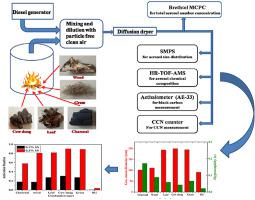Atmospheric Environment ( IF 4.2 ) Pub Date : 2021-09-15 , DOI: 10.1016/j.atmosenv.2021.118726 S. Mukherjee 1, 2 , V. Anil Kumar 1 , R.D. Patil 1 , G.S. Meena 1 , P. Buchunde 1, 2 , V. Waghmare 1 , S. Deshmukh 1 , V. Dhavale 1 , A. Ray 1 , A.S. Panicker 1 , S.M. Sonbawne 1 , P.D. Safai 1 , G. Pandithurai 1

|
The aerosol physico-chemical properties along with their CCN activation characteristics were studied for different combustion source types such as Diesel Generator (DG), wood, leaf, charcoal, grass and cow dung through chamber-based experiment. Aethalometer (AE-33), High resolution time-of-flight aerosol mass spectrometer (HR-TOF-AMS), scanning mobility particle sizer (SMPS) and cloud condensation nuclei (CCN) counter were connected in line to derive the absorption properties, chemical composition, size distribution and CCN number concentrations respectively. Angstrom absorption exponent (AAE) and Angstrom absorption exponent ratio (AAER) were estimated utilizing the Aethalometer data. The analysis reveals that the DG emission was associated with the lowest AAE value (0.92) and the AAE value was highest for cow dung emissions (2.15). AAER, a ratio of AAE at longer wavelengths (660–950 nm) to smaller wavelengths (370-660 nm), showed value < 1 for most of biomass burning types, whereas, the AAER value was >1 for DG emission. The chemical composition data reveals that the organics contribute more than 90% to most of the combustion sources except charcoal, for which the organic contribution was only 78%. High-resolution data analysis reveals that leaf burning was associated with the highest f44 fraction indicating the emitted organic aerosols contain more oxygen. The chemical composition derived hygroscopicity parameter (κ) was estimated to be highest for charcoal emissions and lowest for diesel and cooking emissions. Hygroscopicity parameter (κ) was also evaluated utilizing CCN and SMPS data. The CCN activation and size distribution analysis revealed that the CCN activation of cow dung was highest at 0.1% and 0.3% SS, this is associated with the higher geometric mean diameter (GMD) of emitted aerosols, indicating the importance of size compared to the chemical composition. The activation fraction of charcoal emission was found to be higher than DG emission in these super-saturations, indicating the importance of hygroscopicity in addition to size for governing the CCN activation when the GMD is on the lower side.
中文翻译:

通过腔室实验方法研究不同燃烧源的物理化学特性和相关的 CCN 活化
通过基于腔室的实验,研究了柴油发电机 (DG)、木材、树叶、木炭、草和牛粪等不同燃烧源类型的气溶胶理化性质及其 CCN 活化特性。风速计 (AE-33)、高分辨率飞行时间气溶胶质谱仪 (HR-TOF-AMS)、扫描迁移率粒度仪 (SMPS) 和云凝结核 (CCN) 计数器串联连接以得出吸收特性,分别是化学成分、粒径分布和 CCN 数浓度。埃吸收指数 (AAE) 和埃吸收指数比 (AAER) 使用 Aethalometer 数据进行估计。分析表明,DG 排放与最低的 AAE 值 (0.92) 相关,而牛粪排放的 AAE 值最高 (2.15)。航空航天局,较长波长 (660-950 nm) 与较小波长 (370-660 nm) 的 AAE 比值对于大多数生物质燃烧类型显示 < 1,而对于 DG 排放,AAER 值 > 1。化学成分数据显示,除木炭外,有机物对大部分燃烧源的贡献超过90%,而木炭的有机贡献仅为78%。高分辨率数据分析表明,叶子燃烧与最高的˚F 44分数表明排放的有机气溶胶含有更多的氧气。化学成分衍生的吸湿性参数 (κ) 估计木炭排放最高,柴油和烹饪排放最低。还利用 CCN 和 SMPS 数据评估了吸湿性参数 (κ)。CCN 活化和尺寸分布分析表明,牛粪的 CCN 活化最高为 0.1% 和 0.3% SS,这与排放气溶胶的几何平均直径 (GMD) 较高有关,表明与化学物质相比,尺寸的重要性作品。发现在这些过饱和度中,木炭排放的活化分数高于 DG 排放,这表明当 GMD 处于较低侧时,吸湿性除了控制 CCN 活化的大小外的重要性。









































 京公网安备 11010802027423号
京公网安备 11010802027423号